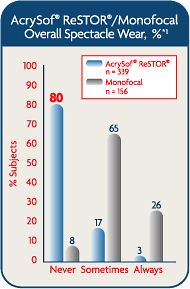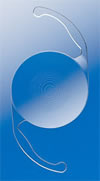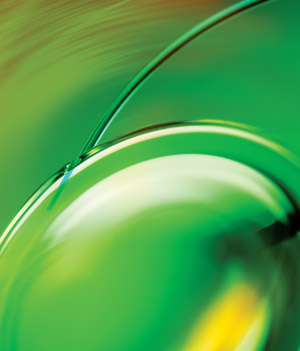|
The vast majority of patients who undergo cataract surgery today receive
monofocal lenses, which typically require them to use reading glasses or
bifocals for near vision following surgery.
 |
|
|
|
"With the new AcrySof ReSTOR IOL, patients have the
potential to reduce their reliance on glasses", said the
doctors. "This new lens is a breakthrough in cataract
surgery that we are proud to offer our patients."
AcrySof ReSTOR is a foldable IOL and represents breakthrough
technology because of its unique, patented optic design, which allows
patients to experience the highest level of freedom from glasses ever
achieved in IOL clinical trials. The AcrySof ReSTOR IOL uses a
combination of three complementary technologies: apodization,
diffraction and refraction, to allow patients to experience a full range
of high-quality vision without the need for reading glasses or bifocals.
This range of vision is achieved without glasses through the optical
properties of the IOL. The end benefit for patients is an increased
range of quality vision that results in a high level of spectacle
freedom. Alcon
patented the application of apodization technology to an IOL, making
AcrySof ReSTOR the first and only apodized diffractive IOL.
|
|
This
innovative lens uses a revolutionary apodized diffractive
technology to give patients a full range of quality vision
(near, intermediate and distance) that greatly increases
their independence from glasses after surgery. The clinical
studies supporting the approval showed that 80 percent of
patients who received the AcrySof ReSTOR lens did not use
glasses for any activities after cataract surgery. The
clinical results also showed that 84 percent of patients who
received the AcrySof ReSTOR lens in both eyes achieved
distance visual acuity of 20/25 or better and near visual
acuity of 20/32 or better without correction by contacts or
glasses while only 23 percent of the conventional or monofocal control group achieved this level. Near visual
acuity of 20/32, or J2, means patients can read the very
small stock quotes in the newspaper |
|
 |
Since its introduction outside the U.S. in 2003, more than 11,000
AcrySof ReSTOR IOLs have been implanted in patients by more than 1,000
surgeons in Europe and other countries. More than 500 ophthalmic
surgeons outside of the U.S. have been trained to implant the AcrySof ReSTOR lens and thousands of lenses have already been successfully
implanted.
|
The AcrySof ReSTOR IOL received approval by the U.S. Food and Drug
Administration in March 2005. Clinical trials were conducted in the
United States and Europe to establish the safety and effectiveness of
the AcrySof ReSTOR IOL.
A cataract is a clouding of the eye's natural lens, which results in
blurred or defocused vision. According to a recent article published in
the Archives of Ophthalmology, more than 20 million adults in the U.S.
have developed cataracts making it the number one cause of poor vision
in the United States. While not all cataracts require surgery, nearly 3
million cataract procedures are annually performed in the U.S. Cataracts
cannot be prevented and are the leading cause of treatable blindness
worldwide. According to the National Eye Institute, the number of
Americans with cataracts is expected to rise to over 30 million people
by the year 2020. |
|
 |
|